 |
 |
 |
| |
Chronic Hepatitis C (HCV) Infections and the
Risk of Depression and Other Adverse Events
|
| |
| |
Reported by Jules Levin
AASLD Nov 2 Boston
Jeffrey McCombs, PhD1, Yong Yuan, PhD2, Janet Shin, PharmD1, Sammy Saab, MD3
1USC School of Pharmacy, Los Angeles, CA, USA; 2Bristol Myers-Squibb, Princeton, NJ, USA; 3David Geffen School of Medicine, UCLA, Los Angeles, CA, USA
This finding immediately below shows why we need vigorous national HCV testing, HCV diagnosies are being made late because patients are not getting tested & identified early:
"In the year following the diagnosis of HCV in patients without known cirrhosis, nearly 25% of HCV patients experienced depression and 14% had a cirrhosis diagnosis reported. The incidence rate for hepatic cell cancer was over 1 per hundred HCV patients in the first year compared to 5 per 10,000 in the matched, non-HCV population"
CONCLUSIONS
This study estimates the extent to which HCV significantly increases the risk of adverse clinical events by comparing matched HCV and non-HCV populations.
HCV doubles the risk of depression and increases the risk of cirrhosis by 80-fold. The likelihood of liver transplantation was increased by a factor of over 60, while the likelihood of developing liver cancer increased 25-fold. Odds ratio data can be misleading if the absolute risk of the event is very low. This is not the case here.
In the year following the diagnosis of HCV in patients without known cirrhosis, nearly 25% of HCV patients experienced depression and 14% had a cirrhosis diagnosis reported.
The incidence rate for hepatic cell cancer was over 1 per hundred HCV patients in the first year compared to 5 per 10,000 in the matched, non-HCV population. Liver transplantation remains relatively uncommon in the HCV sample at 58 transplants per 10,000.
In a sensitivity analysis [Figure 6], we found that treated HCV patients had higher rates of depression than un-treated HCV patients during the first year. These results highlight the need for safe, tolerable and effective antiviral therapies. With new therapies under development, there is a need for data on the incremental impact of HCV on the risk of hepatic events and depression. The data presented here can be used in future evaluations of the cost effectiveness of new therapies.
BACKGROUND
Hepatitis C (HCV) is a major medical and public health concern worldwide. In the United States, the Centers for Disease Control estimate the prevalence of chronic HCV at between 2.7 and 3.9 million Americans.1 The cost associated with chronic HCV infection in the U.S. was estimated at $1.8 billion in 1997 and these costs are expected to increase significantly over the next 2 decades.2,3 Serious complications of HCV may develop, such as liver failure,
liver transplantation and cancer.
HCV patients may suffer from depression which is thought to be associated with treatment. However, a rigorous study design is required to measure the incremental effects of HCV on the risk of depression and other adverse clinical outcomes. Specifically, HCV patients must be compared to similar patients without an HCV diagnosis and multi-variable statistical methods are required to adjust for any remaining potential confounding factors.

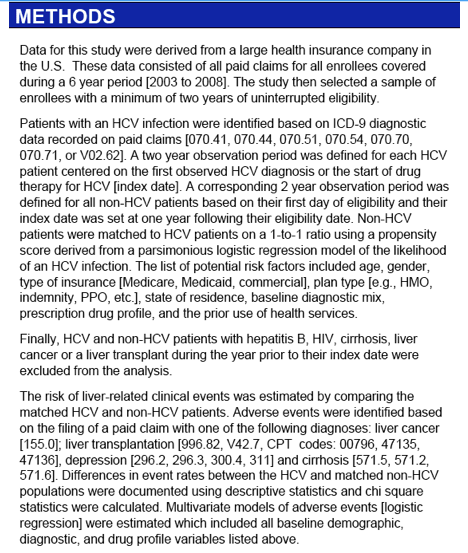

A total of 60,806 HCV patients were identified using the 6 years of paid claims data based on two or more HCV related diagnoses or a single diagnosis combined with a prescription for ribavirin, interferon-alpha, pegylated interferon-alpha or interferon-alfcon. Of this HCV population, only 8,861 patients [14.6%] exhibited a full year of eligibility prior to their index date without any evidence of cirrhosis, liver cancer or liver transplantation. An additional 410,605 non-HCV patients were identified using the 6 years of paid claims data who also had a minimum of 2 years of continuous eligibility and no evidence of HCV related adverse events in the pre-index year. These 419,466 patients were used to estimate logistic models of the factors associated with HCV infection. The factors found to be significantly
associated with HCV are summarized in Figures 1-4.
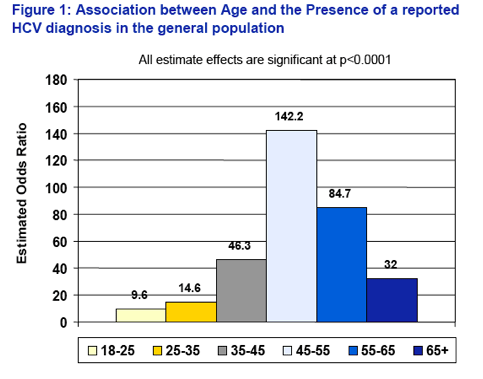
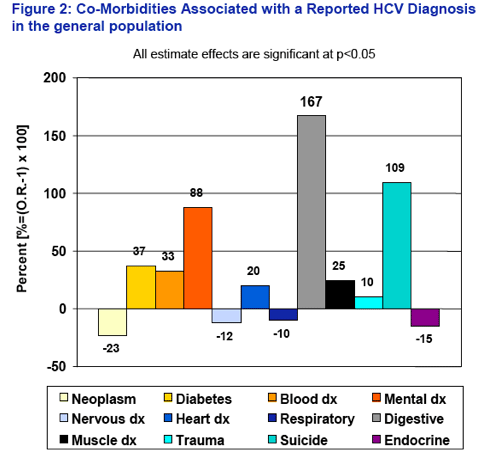

The results from the propensity score model of the risk factors associated with HCV are consistent with the literature. Patients aged 35 and above are at much greater risk than younger patients, especially patients aged 45-55 on their index date during the period 2003-2008. Males are twice as likely as females to be infected with HCV and the risk is much higher for patients living in the south relative to the west, mid-west or north east.
The results of the propensity score model were used to match 8,861 HCV patients with 8,861 non-HCV patients. The matched HCV and non-HCV patients did not differ significantly on any pre-index characteristics including demographic characteristics, health insurance coverage, prior use of services, health care cost, prescription drug profile or co-morbidity profile [data not presented].
The simple counts of adverse events in the post-index year are presented in Figure 4. Estimates of the incremental impact of HCV on event risk were estimated using logistic regression models and these results are compared to the unadjusted odds ratios based on counts in Figure 5. The rate of depression in the first year is presented in Figure 6 broken down by treatment status documenting higher rates of depression in treated HCV patients.
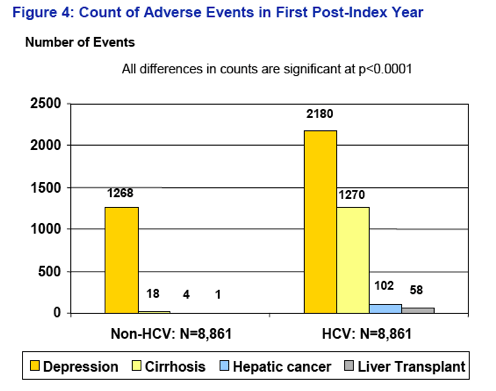
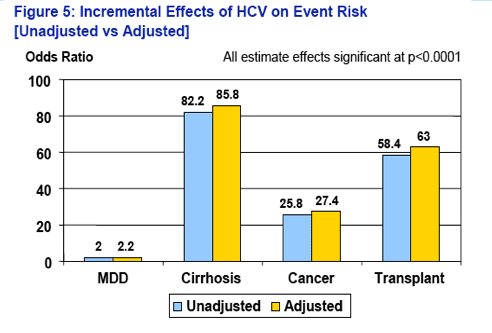
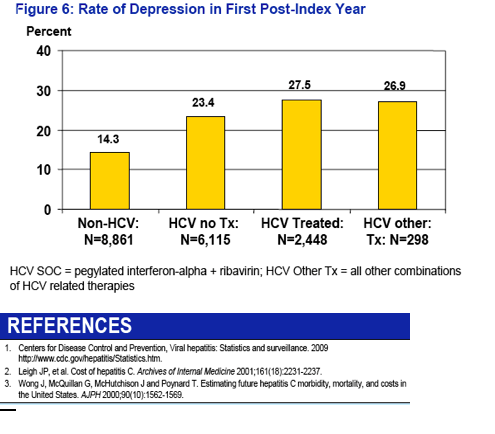
|
| |
|
 |
 |
|
|